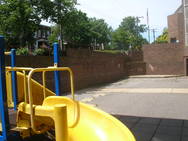Don’t forget about playgrounds

Author’s playground in 2006 at the now closed Shaed Elementary.
Playgrounds serve an important role in child development. They’re not just luxuries or “add-ons” in neighborhoods. Playgrounds and public parks are where children in cities gain crucial physical and social skills.
To maximize learning during and after school, especially for our youngest learners, we should think about playgrounds as a public educational good, just as we do schools, libraries, and museums.
As a teacher at a charter school in commercial space, publicly accessible playgrounds were essential to my educational approach. My students leapt, danced, climbed, explored, and played on two nearby DC Parks and Recreation playgrounds — Petworth and Upshur Rec Centers.
At Petworth, we were joined by many nannies, parents, and center and home based child care providers in the neighborhood. At Upshur, which also had a high profile renovation, we shared the space with another nearby elementary school — all enjoying the essential joy and learning that comes from outdoor play. From my perspective, all playgrounds aren’t created equally.
Some DC playgrounds are exciting and safe, others are dismal and in disrepair. Amidst the conversations we are having about facilities renovations and making the best use of our public space, it seems there is a lot of room for improvement in our playgrounds.
There are at least three major things we should consider in ensuring DC children are well-served by playgrounds:
Location: It’s crucial playgrounds are walkable for families and kids, avoiding large gaps in accessibility across the city.
Overall, there is mixed evidence on how well DC is served. It all depends on where you live — and we continue to need better data about where playgrounds actually are located. My neighborhood has several playgrounds in walking distance, but small distances can make a difference for families and kids’ ability to access them.
Compared to other cities, DC has a relatively low number of playgrounds for its residents. Many neighborhoods like the Southwest neighborhood in Ward 6, are recognizing the lack of playgrounds and organizing to build them.
Quality: Playgrounds should be in good repair, with lots of variety. They must have adequate safety elements, like a soft landing pad, and equipment that targets different skills, from a balance beam (agility) to monkey bars (strength) to steering wheels (imaginative play).
The city is embarking on a large scale playground renovation to do just that — ensuring more playgrounds will be in better repair soon. In renovation or new construction, it would be ideal to see more playgrounds provide truly challenging motor play, with swing sets and tall climbing structures.
Accessibility: While there are some valid reasons for protecting playgrounds’ quality and durability through limiting access, many public playgrounds are often closed irregularly. Overall, it’s better to view playgrounds as strong public goods that everyone has the right to use than something that must be overly “saved” or “preserved” when they could be put to good use! I hate seeing public school or church playgrounds closed to the public, and it certainly is a trend throughout the city.
Again, it’s easy to find information about hours and accessibility for DC Parks and Recreation center playgrounds, but overall there is a lack of information for the average person looking for a great playground.
Crowdsourcing can help parents find out about playgrounds
How can we make this public good, a real tool for educational growth across our communities, work better for all of us? There are lots of reviews of local playgrounds as well as basic information from the city, but one way to bring together quick and accurate knowledge of existing playgrounds and playground needs is through crowdsourcing.
One handy map of local playgrounds nationwide is from a national nonprofit headquartered here in DC, Kaboom! Dedicated to enhancing play opportunities in communities, Kaboom! Has a really useful app and web interface to explore local playgrounds.
The app features a wealth of information that users can add to. For instance, in my neighborhood of Hill East, there are numerous entries for playgrounds, but also for public green spaces and sports fields. There’s the sports field at Eastern High School, the playgrounds at Payne Elementary and Center City Public Charter School.
However, the information is only as good as the inputs — Payne Elementary erroneously shows up in both SE and NE, and Eastern’s entry says “open to the public during non-school hours.” This is only partially true: you can definitely play tennis there, but you can’t get on the track, so that’s something I’m going to update.
Since I have been known to toss balls back over the fence at Center City’s small playground, next to the convent, I also know it has irregular hours but is often open to the neighborhood families as well as students on weekdays. I’ve got my neighborhood covered for the next few weeks — what about yours?
We know we want high quality (fun!) and accessible playspaces that are in convenient locations for families and children across the city. As we build out the data that’s available on Kaboom!‘s app and around the web, — where else do we need playgrounds? What neighborhoods are underserved? What playgrounds are not usable, or need attention?

